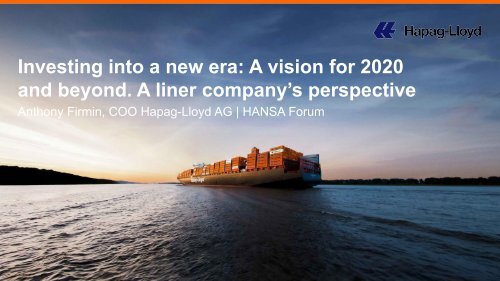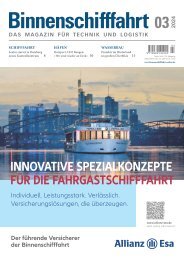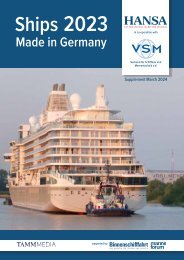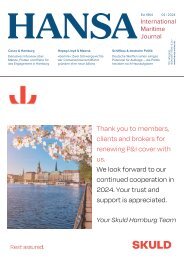Anthony J. Firmin / »A vision for 2020 and beyond« / HANSA-Forum 2018
Create successful ePaper yourself
Turn your PDF publications into a flip-book with our unique Google optimized e-Paper software.
Investing into a new era: A <strong>vision</strong> <strong>for</strong> <strong>2020</strong><br />
<strong>and</strong> beyond. A liner company’s perspective<br />
<strong>Anthony</strong> <strong>Firmin</strong>, COO Hapag-Lloyd AG | <strong>HANSA</strong> <strong>Forum</strong>
Hapag-Lloyd’s recent mergers have increased the<br />
company’s international footprint<br />
With our 226 modern ships, 120 services <strong>and</strong> offices in 127 countries we are a truly global player<br />
<strong>and</strong> there<strong>for</strong>e we are constantly dealing with a large number of local <strong>and</strong> global regulations<br />
One<br />
Global<br />
presence<br />
127<br />
Countries in<br />
five regions<br />
+600<br />
ports called<br />
7<br />
Continents<br />
2
We are stronger today <strong>and</strong> have the best expertise on board<br />
People<br />
12,600<br />
Volume<br />
7,000<br />
11,700 TTEU<br />
5,900 TTEU<br />
2014 9M <strong>2018</strong><br />
2014 LTM 9M <strong>2018</strong><br />
Ø Vessel size & age<br />
7,200 TEU<br />
Revenue<br />
USD 13,200 m<br />
5,300 TEU<br />
USD 9,050 m<br />
8.7 years 7.5 years<br />
2014 9M <strong>2018</strong><br />
2014 LTM 9M <strong>2018</strong><br />
3<br />
Note: Rounded figures
Regulatory challenges have always<br />
played a role in shipping<br />
Hapag-Lloyd has successfully adopted new regulations<br />
throughout its history <strong>and</strong> this is why we will tackle the<br />
challenges the IMO<strong>2020</strong> Low Sulphur regulation poses<br />
Tier III<br />
IMO<strong>2020</strong><br />
24-hour rule SOX max 3.5%<br />
ISPS*<br />
Shipwrecking<br />
Ballast water<br />
…<br />
4<br />
*ISPS = International Ship <strong>and</strong> Port Facility Security (ISPS) Code
As of <strong>2020</strong>, all ships will be required to use fuel with 0.5% sulphur<br />
content or less on all the world‘s ocean<br />
IMO<strong>2020</strong> is the first in a series of steps by the International Maritime Organization (IMO) to<br />
reduce emissions in response to climate change.<br />
3.5%<br />
or less<br />
11/<strong>2018</strong><br />
0.5%<br />
or less<br />
01/<strong>2020</strong><br />
SULPHUR CONTENT<br />
5<br />
4.5<br />
4<br />
3.5<br />
3<br />
2.5<br />
2<br />
1.5<br />
1<br />
0.5<br />
Outside ECAs<br />
Inside ECAs<br />
0<br />
2005 2007 2009 2011 2013 2015 2017 2019 2021 2023<br />
PROGRESSION OF THE MAXIMUM PERMISSIBLE SULPHUR<br />
CONTENT OF MARINE FUELS<br />
Complying with the new low sulphur regulation will make the industry significantly greener, but<br />
compliance will have a significant cost impact on the industry, Hapag-Lloyd, <strong>and</strong> customers<br />
55<br />
Note: Stricter 0.1% sulphur regulations will remain in the emission control areas in Europe <strong>and</strong> North America<br />
Source <strong>for</strong> Maximum Permissable Sulphur Content; Alphatanker, The Marine Fuel Market: Challenges And Opportunities, <strong>2018</strong><br />
0.1% sulphur limit<br />
0.5% sulphur limit
Low Sulphur fuel oil is the key solution <strong>for</strong> Hapag-Lloyd <strong>and</strong> the<br />
industry to ensure compliance in the short term<br />
Industry has three promising options <strong>for</strong> ensuring compliance. However, the majority of all<br />
vessels in the shipping industry are expected to be operated with low sulphur fuel oil by<br />
<strong>2020</strong>. It is also currently the most environmentally friendly option.<br />
1 2 3<br />
Liquefied natural<br />
gas (LNG)<br />
Exhaust gas<br />
cleaning systems<br />
Compliant<br />
fuels<br />
Estimated mix of solutions <strong>for</strong> fleet as of <strong>2020</strong> – The majority of vessels is expected to run<br />
on compliant fuel<br />
76
Compliant fuels are the only realistic<br />
solution <strong>for</strong> ensuring compliance by <strong>2020</strong><br />
Using compliant fuels is the key solution <strong>for</strong> the industry<br />
<strong>and</strong> Hapag-Lloyd as refitting a sufficient amount of vessels<br />
to LNG or installing enough Exhaust Gas Cleaning Systems<br />
is not feasible by <strong>2020</strong><br />
Pros <strong>and</strong> cons of compliant fuels<br />
7<br />
+ Currently the most environmentally friendly solution<br />
+ Major suppliers have confirmed availability<br />
+ No capital expenditure<br />
– Higher fuel price<br />
– Higher operating expenses<br />
– Possible compatibility problems<br />
– No downtime <strong>and</strong> costs <strong>for</strong> conversion<br />
– Expected additional cost increase of USD 1 billion <strong>for</strong><br />
Hapag-Lloyd annually
The IMO<strong>2020</strong> regulation will make the industry greener but it<br />
will come with a price<br />
Costs will go up as both compliant fuels <strong>and</strong> investments into new technologies will be expensive<br />
On the assumption that the spread between<br />
high-sulphur fuel oil (HSFO) <strong>and</strong> low-sulphur<br />
fuel oil (LSFO 0.5%) will be 250 US dollars per<br />
tonne by <strong>2020</strong>, Hapag-Lloyd estimates its<br />
additional costs of around 1 billion US dollars<br />
annually.<br />
ESTIMATED IMPACT<br />
ON ENTIRE SHIPPING<br />
INDUSTRY<br />
ESTIMATED IMPACT<br />
ON CONTAINER<br />
SHIPPING INDUSTRY<br />
ESTIMATED IMPACT<br />
ON HAPAG-LLOYD<br />
8
To recover fuel related costs caused by the IMO<strong>2020</strong>, Hapag-Lloyd<br />
has developed a Marine Fuel Recovery (MFR) mechanism<br />
• Marine Fuel Recovery Mechanism will be gradually implemented from beginning of<br />
2019 – all customers will take part in this change<br />
• Hapag-Lloyd will replace all existing fuel charges with a new MFR mechanism<br />
e.g.<br />
…<br />
9
The new MFR mechanism is logical,<br />
transparent <strong>and</strong> easy-to-underst<strong>and</strong><br />
Hapag-Lloyd’s MFR mechanism aims to create<br />
transparency <strong>and</strong> is based on a set of variables <strong>and</strong><br />
average market data<br />
• Helps our customers predict <strong>and</strong> plan price increases<br />
• Customer feedback on the MFR has been largely positive<br />
• The MFR is based on market data (fuel consumption, fuel<br />
price <strong>and</strong> carried TEU) <strong>and</strong> averages <strong>for</strong> Market Class<br />
Vessels<br />
• Unique approach also considering price difference between<br />
0.1% <strong>and</strong> 0.5% Low Sulphur Fuel<br />
• Dominant <strong>and</strong> non-dominant legs are treated in the same<br />
way<br />
10
Liquefied Natural Gas (LNG)<br />
Hapag-Lloyd will test operating one vessel with LNG in 2019/<strong>2020</strong>. If the test is<br />
successful, we might convert more vessels.<br />
• Hapag-Lloyd has 17 LNG ready vessels in its fleet <strong>and</strong> is refitting one A 15 class vessel in<br />
2019/20<br />
• LNG might be a solution <strong>for</strong> the mid-term future as it not only has lower sulphur content but<br />
also reduces CO2 as well as other emissions<br />
+<br />
–<br />
• Regulatory certainty<br />
• Lower emissions<br />
• Future availability<br />
• High capital expenditure<br />
• Bunkering network not yet in place<br />
• Availability in ports not yet suf-ficient<br />
• Estimated additional costs <strong>for</strong><br />
conversion <strong>and</strong> newbuilds 25-30<br />
• Attractive payback<br />
11
Exhaust Gas Cleaning Systems (EGCS)<br />
Hapag-Lloyd will conduct 10 retrofits with exhaust gas cleaning systems<br />
• Hybrid scrubbers will be installed to 10 Hamburg Class vessels (13,000 TEU)<br />
• Due to environmental reasons Exhaust Gas Cleaning Systems are only a short- to mid-term<br />
solution<br />
+<br />
–<br />
• Lower capital investment than LNG<br />
• No issues with fuel (HSFO 3.5%)<br />
• Economically attractive<br />
• Proven base technology<br />
• Increased fuel consumption <strong>and</strong><br />
higher CO2<br />
• Direct discharge of scrubber water<br />
into the ocean<br />
• Short-term solution<br />
• Estimated installation cost USD 7-10<br />
million per ship<br />
• Attractive payback<br />
12
Governance is crucial – Hapag-Lloyd<br />
welcomes the Carriage Ban<br />
A robust en<strong>for</strong>cement regime is necessary <strong>for</strong><br />
ensuring a level playing field<br />
• The International Maritime Organization itself has no<br />
authority <strong>for</strong> governance<br />
• Instead each Flag <strong>and</strong> port state is responsible <strong>for</strong><br />
en<strong>for</strong>cing the regulation with sanctions <strong>and</strong> fines<br />
• The strict control in ports is extremely important<br />
• Carriage Ban as of March 1, <strong>2020</strong><br />
As a tool <strong>for</strong> en<strong>for</strong>cement, the IMO Bans vessels that<br />
are not equipped with scrubbers to carry fuel with<br />
higher Sulphur content than 0.5%<br />
Hapag-Lloyd is a member of the Trident Alliance<br />
The Trident Alliance is a network of ship owners <strong>and</strong> operators<br />
who share a common interest in robust <strong>and</strong> effective en<strong>for</strong>cement<br />
of maritime sulphur regulations<br />
13
Will the new regulation affect the supply - dem<strong>and</strong> balance in<br />
liner shipping?<br />
Disadvantage of inefficient vessels will become more apparent as older vessels need to use<br />
more expensive fuels<br />
Fuel costs per day <strong>for</strong> an old<br />
4,000 TEU vessel<br />
[USD/day]<br />
+$224,250<br />
+62.5%<br />
32,850<br />
Illustrative<br />
+$138,000<br />
20,216<br />
+$3,943<br />
Cost per sea day<br />
@ 400 USD/mt<br />
Cost per sea day<br />
@ 650 USD/mt<br />
• Might lead to increased scrapping of older, less efficient vessels…<br />
• …which would further improve supply - dem<strong>and</strong> balance<br />
14
Wrap-up<br />
Key takeaways<br />
• IMO <strong>2020</strong> will effect the industry as a whole<br />
Regulation <strong>2020</strong><br />
• Three options are available to achieve compliance (LNG, EGCS, compliant fuels)<br />
• Majority of containerships will run on compliant fuel as of <strong>2020</strong><br />
Hapag-Lloyd’s<br />
approach<br />
• Hapag-Lloyd embraces new regulation as industry is becoming greener<br />
• We will test LNG <strong>and</strong> install 10 EGCS<br />
• Using compliant fuels is the key solution <strong>for</strong> the industry <strong>and</strong> Hapag-Lloyd<br />
• MFR mechanism in place to tackle higher bunker costs<br />
Going <strong>for</strong>ward<br />
• Positive result from LNG test might lead to further installations<br />
• IMO en<strong>vision</strong>s significant emission reduction by 2050 <strong>and</strong> wants to be emission free by 2100<br />
15
Thank you very much!
DISCLAIMER<br />
STRICTLY CONFIDENTIAL<br />
This presentation is provided to you on a confidential basis. Delivery of this in<strong>for</strong>mation to any other person, the use of any third-party data or any<br />
reproduction of this in<strong>for</strong>mation, in whole or in part, without the prior written consent of Hapag-Lloyd is prohibited.<br />
This presentation constitutes neither an offer to sell nor a solicitation to buy any securities in the United States, Germany or any other jurisdiction.<br />
This presentation contains <strong>for</strong>ward looking statements within the meaning of the 'safe harbor' pro<strong>vision</strong> of the US securities laws. These statements are based<br />
on management's current expectations or beliefs <strong>and</strong> are subject to a number of factors <strong>and</strong> uncertainties that could cause actual results to differ materially<br />
from those described in the <strong>for</strong>ward-looking statements. Actual results may differ from those set <strong>for</strong>th in the <strong>for</strong>ward-looking statements as a result of various<br />
factors (including, but not limited to, future global economic conditions, market conditions affecting the container shipping industry, intense competition in<br />
the markets in which we operate, potential environmental liability <strong>and</strong> capital costs of compliance with applicable laws, regulations <strong>and</strong> st<strong>and</strong>ards in the<br />
markets in which we operate, diverse political, legal, economic <strong>and</strong> other conditions affecting the markets in which we operate, our ability to successfully<br />
integrate business acquisitions <strong>and</strong> our ability to service our debt requirements). Many of these factors are beyond our control.<br />
This presentation is intended to provide a general overview of Hapag-Lloyd’s business <strong>and</strong> does not purport to deal with all aspects <strong>and</strong> details regarding<br />
Hapag-Lloyd. Accordingly, neither Hapag-Lloyd nor any of its directors, officers, employees or advisers nor any other person makes any representation or<br />
warranty, express or implied, as to, <strong>and</strong> accordingly no reliance should be placed on, the fairness, accuracy or completeness of the in<strong>for</strong>mation contained in<br />
the presentation or of the views given or implied. Neither Hapag-Lloyd nor any of its directors, officers, employees or advisors nor any other person shall have<br />
any liability whatsoever <strong>for</strong> any errors or omissions or any loss howsoever arising, directly or indirectly, from any use of this in<strong>for</strong>mation or its contents or<br />
otherwise arising in connection therewith. The material contained in this presentation reflects current legislation <strong>and</strong> the business <strong>and</strong> financial affairs of<br />
Hapag-Lloyd which are subject to change <strong>and</strong> audit, <strong>and</strong> is subject to the pro<strong>vision</strong>s contained within legislation.<br />
The distribution of this presentation in certain jurisdictions may be restricted by law. Persons into whose possession this presentation comes are required to<br />
in<strong>for</strong>m themselves about <strong>and</strong> to observe any such restrictions. Neither this presentation nor anything contained herein shall <strong>for</strong>m the basis of, or be relied on<br />
in connection with, any offer or commitment whatsoever. In particular, this presentation does not constitute an offer to sell or a solicitation of an offer to buy<br />
securities of Hapag-Lloyd in the United States. Securities of Hapag-Lloyd may not be offered or sold in the United States of America absent registration or an<br />
exemption from registration under the U.S. Securities Act of 1933, as amended.<br />
17


















